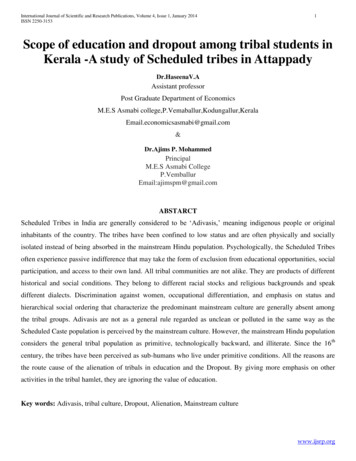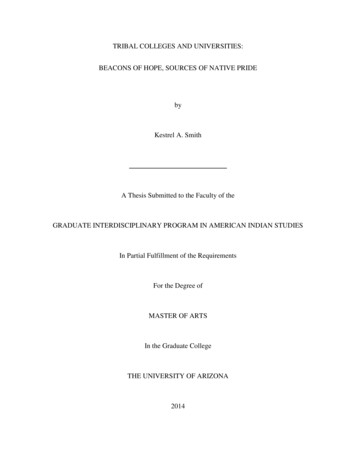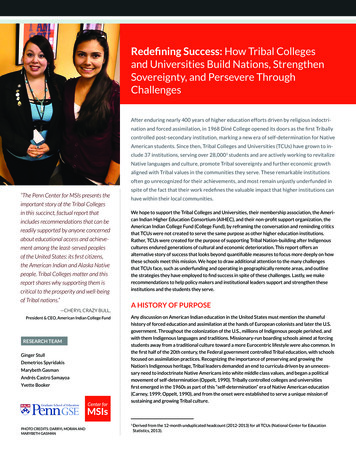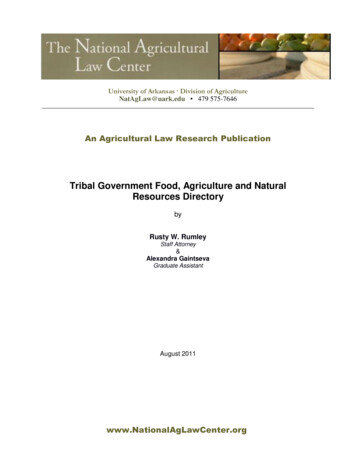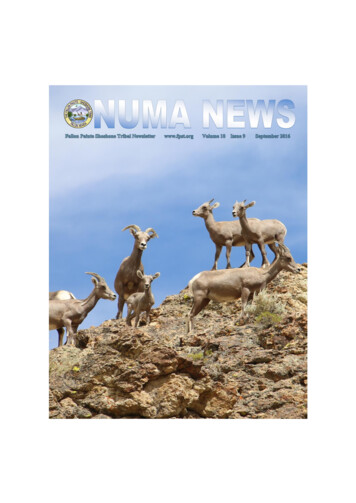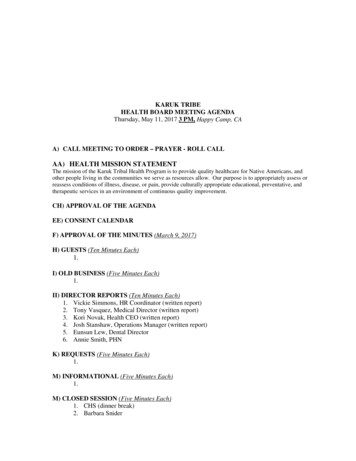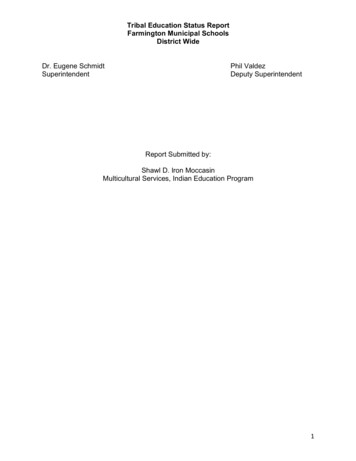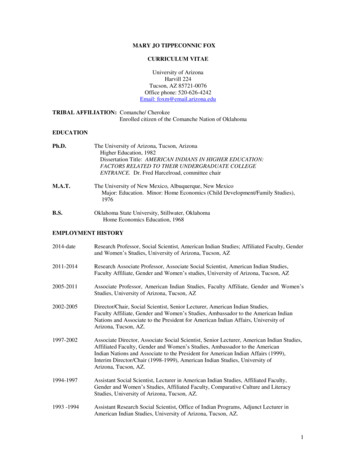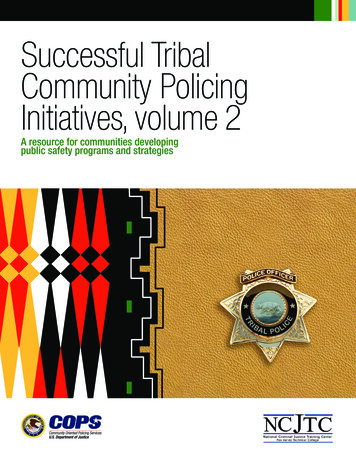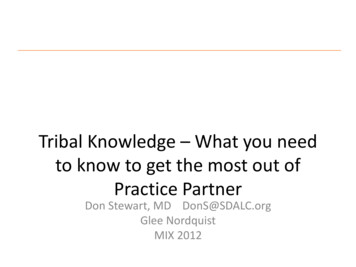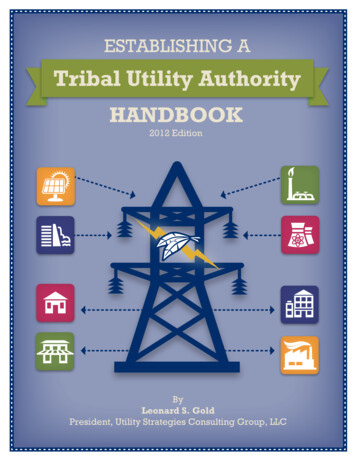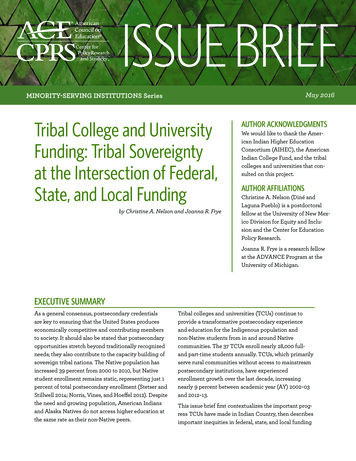
Transcription
ISSUE BRIEFMay 2016MINORITY-SERVING INSTITUTIONS SeriesTribal College and UniversityFunding: Tribal Sovereigntyat the Intersection of Federal,State, and Local Fundingby Christine A. Nelson and Joanna R. FryeAUTHOR ACKNOWLEDGMENTSWe would like to thank the American Indian Higher EducationConsortium (AIHEC), the AmericanIndian College Fund, and the tribalcolleges and universities that consulted on this project.AUTHOR AFFILIATIONSChristine A. Nelson (Diné andLaguna Pueblo) is a postdoctoralfellow at the University of New Mexico Division for Equity and Inclusion and the Center for EducationPolicy Research.Joanna R. Frye is a research fellowat the ADVANCE Program at theUniversity of Michigan.EXECUTIVE SUMMARYAs a general consensus, postsecondary credentialsare key to ensuring that the United States produceseconomically competitive and contributing membersto society. It should also be stated that postsecondaryopportunities stretch beyond traditionally recognizedneeds; they also contribute to the capacity building ofsovereign tribal nations. The Native population hasincreased 39 percent from 2000 to 2010, but Nativestudent enrollment remains static, representing just 1percent of total postsecondary enrollment (Stetser andStillwell 2014; Norris, Vines, and Hoeffel 2012). Despitethe need and growing population, American Indiansand Alaska Natives do not access higher education atthe same rate as their non-Native peers.Tribal colleges and universities (TCUs) continue toprovide a transformative postsecondary experienceand education for the Indigenous population andnon-Native students from in and around Nativecommunities. The 37 TCUs enroll nearly 28,000 fulland part-time students annually. TCUs, which primarilyserve rural communities without access to mainstreampostsecondary institutions, have experiencedenrollment growth over the last decade, increasingnearly 9 percent between academic year (AY) 2002–03and 2012–13.This issue brief first contextualizes the important progress TCUs have made in Indian Country, then describesimportant inequities in federal, state, and local funding
that limit these institutions’ ability to further theirimpact on the tribal communities they are chartered to serve. In this analysis, we identify fivenotable points: TCUs are perpetually underfunded through thefederal Tribally Controlled Colleges and Universities Assistance Act of 1978 (TCCUAA). The formula for federal funds only allocatesmoney for Native students. TCUs receive zerofederal funding for non-Native students. Unlike other public minority-serving institutions,state and local governments have no obligationto appropriate funding to TCUs. TCUs are limited in their ability to increasetuition to fill revenue gaps, unlike other mainstream public institutions. The chronic underfunding of TCUs mayjeopardize the educational attainment ofIndigenous students, exacerbating attainmentgaps that exist between Native and non-Nativepopulations.THE TRIBAL COLLEGE AND UNIVERSITY MOVEMENTFollowing the colonization of the Americas, formalized education for North American Indigenous1students was rooted firmly in tactics of assimilationand eradication of tribal identity and language(Reyhner and Eder 2004; Szasz 2003). Recognizingthe historical social barriers faced by Native students and the failure of mainstream colleges anduniversities to adequately serve them, tribal leadersbegan a movement toward tribally self-determinedpostsecondary education (McSwain and Cunningham 2006).In 1968, the first tribally controlled collegeemerged on the remote southwest location of theNavajo Nation. Navajo Community College, nowknown as Diné College (AZ), systemically alteredthe vision and meaning of higher education forIndigenous people of North America (Stein 2009).The development of TCUs was a collaborativeeffort within and across tribal nations and allieswith the overall goal of “protecting and enhancingtheir own [tribal] cultures and at the same timeembracing many of the tools of standard postsecondary education” (Stein 2009, 18). Since then, 37tribal colleges, which enroll nearly 28,000 full- andpart-time students annually, have been charteredacross the United States to meet the immediate1234and unique needs of Indian Country.2 The demandfor postsecondary education at TCUs continues togrow—enrollment increased 9 percent between AY2002–03 and AY 2012–13.3 In addition to serving asa hub for higher education learning, approximately100,000 community members participated incommunity education programs at TCUs.4 Amongmany other types of programs, such events includehealth and wellness, financial literacy, and culturalpreservation programs.This responsiveness to the higher education needsof communities across Indian Country, many ofwhich are currently underserved by mainstreamcolleges and universities, continues to be thestrength of TCUs. However, this also leads todiverse institutional conditions across TCUs, andchallenges the notion that TCUs are a monolithicgroup. TCUs, in comparison to most mainstreampostsecondary institutions, are still in their infancyand are developing their institutional capacitydespite facing unstable and inadequate publicfunding. The importance of TCUs in meetingnational goals of improving postsecondary accessand attainment necessitates further investigationinto how funding inequities are hindering the progress of these institutions.American Indians and Alaska Natives will be interchangeably referred to as Native or Indigenous throughout this brief.Derived from the IPEDS 12-month unduplicated headcount at TCUs (AY 2012–13). This figure does not include Comanche Nation,Muscogee Nation, and Wind River.Derived from the IPEDS 12-month unduplicated headcount (AY 2002–03 and AY 2012–13) for all students attending TCUs. Doesnot include Comanche Nation, Muscogee Nation, and Wind River.Figure derived from the 2013–14 AIHEC American Indian Measures of Success (AIMS) Key Indicator System (AKIS).Tribal College and University Funding: Tribal Sovereignty at the Intersection of Federal, State, and Local Funding2
HOW ARE TCUs FUNDED?The composition of revenue sources differs considerably between TCUs and other public institutions, as highlighted in Figure 1.5 Public sources(federal, state, and local appropriations, grants,and contracts) accounted for the largest share ofrevenues across all public institution types, onaverage, in AY 2013–14.6 However, TCUs received asignificantly higher proportion of their total revenue from federal sources, averaging between 71 and74 percent at two- and four-year TCUs, respectively.Compared to public non-TCUs, which receiveless than 25 percent of their revenue from federalsources on average, two- and four-year TCUs arehighly dependent upon federal funding.Figure 1. Average Revenue Snapshot at TCUs and Public Non-TCUs, AY 2013–141009024.8%18.7%Federal appropriations, grants, and contracts807070.7%State appropriations, grants, and contracts*73.7%32%Percent605033.8%Local appropriations, grants, and contracts3.4%4013.6%3020100Net tuition and feesOther revenue*9%6.2%8.9%9.1%6.7%TCU two-year(N 18)37.7%27%Private, investment, and endowment revenue*6%4.1%3.6%TCU four-year Non-TCU two-year Non-TCU four-year(N 18)(N 18)(N 18)Source: Integrated Postsecondary Education Data System (IPEDS)*Data below 3% is not marked.Another major difference between TCUs and nonTCUs is the share of funding provided by stateand local governments. State and local fundingis a significant source of institutional revenue atpublic non-TCUs, but accounts for a relativelysmall percentage of total revenue at TCUs. TCUsare founded and chartered by their respective56American Indian tribes, which hold a speciallegal relationship with the federal government,actualized by more than 400 treaties, severalSupreme Court decisions, prior congressionalaction, and the ceding of more than 1 billion acresof land to the federal government. Because of thegovernment-to-government relationship, the statesOne of the barriers to fully describing the public funding inequities faced by TCUs is incomplete data reporting over time. Federalreporting requirements are time-consuming and require significant staff effort, which is difficult for institutions such as TCUswhere staff and faculty are already taking on multiple roles in daily institutional operations (AIHEC 2012). Persistent fundinginequities harm the capacity of TCUs to create data systems needed to inform institutional effectiveness and improvement. In theabsence of consistent longitudinal data, we focus our analysis on a snapshot of the current financial characteristics of TCUs. SeeFigure 3 for the list of TCUs included in the data analysis.Total revenue excludes hospital and auxiliary revenues, as these operations are generally self-supporting.Tribal College and University Funding: Tribal Sovereignty at the Intersection of Federal, State, and Local Funding3
have no obligation to fund the operations of TCUs,and in most cases states do not—not even for theirnon-Native state residents that attend TCUs.In comparison to other public institutions, TCUsreceive only a small share of their total revenuefrom tuition and fees (around 9 percent, on average). In AY 2013–14, tuition and fees at 24 out of 32TCUs were below the national averages at publictwo- and four-year institutions.7 Even with relatively low tuition rates, TCUs also provided 1.28million in tuition waivers and discounts in AY2009–10 to help meet the financial needs of theirstudents (AIHEC 2012). While many public highereducation institutions have resorted to increasingtuition to offset declines in government fundingover the last two decades, TCUs are constrained intheir ability to raise tuition in at least two ways: The majority of students served by TCUsface significant economic barriers such asextremely high rates of poverty and unemployment. The average annual income of studentsattending TCUs in AY 2009–10 was below 18,000, and at least 75 percent of studentsattending TCUs are Pell Grant recipients(AIHEC 2012). Because federal student loans are not practicalfor most TCU students, given the aforementioned high rates of poverty and unemployment, few of the TCUs participate in the federalstudent loan program, and all are committed tokeeping tuition low to preserve access for thestudents in their tribal communities (AIHEC2012).Revenue from private and other sources represented a small share of total institutional revenueat both TCUs and other public institutions in AY2013–14. Like many public higher education institutions, TCUs do not derive a substantial amountof their revenue from private gifts or endowments.Also, despite popular belief, not all tribal casinosare multimillion-dollar enterprises, as most are notlocated near highly populated, urban areas. Rather,most tribal casinos resemble small businesses, andthe gaming tribes that have chartered a TCU areable to provide only modest, if any, financial support to their college or university (AIHEC 2015).HIGHLIGHTING INEQUITIES IN PUBLIC FUNDING FOR TCUsState and Local FundingAs described previously, state governments haveno obligation to appropriate funding to TCUs.Although it is rare, some states do allocate fundingto TCUs to help support the costs of enrolling bothNative and non-Native students. Two states (NorthDakota and Montana) currently provide financialsupport to TCUs in the form of an allocation pernon-Native student, which partially subsidizes thecosts of educating these students. Arizona providesa yearly sum to TCUs to be used toward capitalexpenses and maintenance (funded through a portion of tax revenues collected on reservation lands).However, the majority of states do not provide anyfinancial support to TCUs, even as these institutions enroll significant numbers of non-Native stateresidents.878TCUs also face challenges related to establishinglocal systems of funding. TCUs are not able tobenefit from local property tax revenue, an important source of funding for non-TCU communitycolleges, because Indian reservations’ status asfederal trust territory prevents the levying of suchtaxes (AIHEC 1999). Similarly, although tribeshave the sovereign authority to levy income taxeson their members, reservations’ high poverty andunemployment rates limit the development of areservation tax base (AIHEC 2015).Federal FundingFederal funding, the largest and most importantsource of funding for TCUs, is allocated through acomplex series of titles within the Tribally Controlled College or University Assistance Act of 1978Authors’ calculations using data from the National Center for Education Statistics Digest of Education Statistics, 2013.Fond du Lac Tribal and Community College (MN) (FDLTCC), as a dual status tribal college and community college, is eligible forstate funding sources inaccessible by other TCUs.Tribal College and University Funding: Tribal Sovereignty at the Intersection of Federal, State, and Local Funding4
(TCCUAA).9 The political and tribal circumstancessurrounding the creation of each TCU determinehow the institution is authorized and the type offederal funding to which it is entitled. Thirty of the37 TCUs are funded through the four federal funding streams authorized by the TCCUAA to supportoperational expenses for TCUs (AIHEC and theInstitute for Higher Education Policy 1999).10 Thesefunding streams are managed and distributed bythe Bureau of Indian Affairs (BIA):11 Title I and II:12 Authorization is earmarkedfor core operating expenses and calculatedthrough the Indian Student Count (ISC), whichis a formula based on the number of Nativeenrolled full-time equivalent students.13 Title III: Authorizes up to 10 million formatching funds for endowment grants; however, only 109,000 are appropriated each year. Title IV: Authorizes funds to support projectsthat engage local economic development; however, this program has never been funded.Federal authorizations under the TCCUAA supportTCUs in various capacities; however, the formulafor those appropriations and the actual dollaramount allocated to institutions are far from equitable. For fiscal 2015, Title I and II were authorizedat 8,000 per student, yet TCUs only received 6,355 per Indian student toward their operatingbudgets (AIHEC 2015). In the past 10 years, authorization increased from 6,000 to 8,000, whileallocation increased from just 4,447 to 6,355 (Figure 2). Despite increases in both authorization andallocation, federal funding has not kept up with thesteady growth of the Native population at TCUsduring this time period.Figure 2. Federal Appropriations per Indian Student Count at TCUs, FY 1999–2015 9,000 8,000 8,000 7,000 6,000 6,000 5,235 4,000 3,000 6,355 6,000 5,000 8,000 4,447 2,964 2,000 1,000019992005Authorized20112015AllocatedSource: Integrated Postsecondary Education Data System (IPEDS)910111213TCUs receive a limited amount of additional federal funding due to their status as land-grant institutions (determined by theEquity in Educational Land-Grant Status Act of 1994).Several TCUs—Haskell Indian Nations University (KS), Southwest Indian Polytechnic Institute (NM), and the Institute of American Indian Arts (NM)—are funded and operated directly by the BIA.Due to the BIA and TCU relationship, TCUs are required to submit operational expenses to IPEDS and the BIA, through BIAForm 6259: nt/idc1-032336.pdf.Title II is allocated to only Diné College.For further explanation see U.S. Code Title 25, Chapter 20, Section 1801.Tribal College and University Funding: Tribal Sovereignty at the Intersection of Federal, State, and Local Funding5
In addition to not being appropriated funds to fullauthorization levels, TCUs that receive ISC fundsdo not receive any federal allocation to support thecosts of educating non-Native students. On average, 16 percent of the student population at TCUsis non-Native14 (Figure 3). The lack of federal support for non-Native students has important financial implications for TCUs and continues to strainTCUs’ operating budgets, which are already struggling with federal underfunding. Beyond fundingallocation, ISC further complicates an accuratecalculation of the percentage of Native studentsserved by TCUs. At TCUs, Native student enrollment follows ISC guidelines, and to be counted asNative a student must be an enrolled member ofa federally recognized tribe or the biological childof an enrolled member of a federally recognizedtribe, whereas at non-TCUs students self-identifyas Native and are not required to provide specifictribal affiliation.Figure 3. Percent of Non-Native Total Student Enrollment at TCUs, AY 2013–14InstitutionIlisagvik CollegeBay Mills Community CollegeCollege of Menominee NationKeweenaw Bay Ojibwa Community CollegeLac Courte Oreilles Ojibwa Community CollegeFort Peck Community CollegeSalish Kootenai CollegeSaginaw Chippewa Tribal CollegeInstitute of American Indian and Alaska Native CultureNueta Hidatsa Sahnish CollegeSisseton Wahpeton CollegeUnited Tribes Technical CollegeTohono O’Odham Community CollegeWhite Earth Tribal and Community CollegeSinte Gleska UniversityCankdeska Cikana Community CollegeAaniiih Nakoda CollegeNavajo Technical UniversityStone Child CollegeLeech Lake Tribal CollegeSitting Bull CollegeNorthwest Indian CollegeChief Dull Knife CollegeLittle Priest Tribal CollegeOglala Lakota CollegeTurtle Mountain Community CollegeNebraska Indian Community CollegeLittle Big Horn CollegeBlackfeet Community CollegeDiné CollegeAverageStatePercent Non-Native %5.56%5.49%5.45%5.33%3.40%3.19%1.77%15.80%Source: Integrated Postsecondary Education Data System (IPEDS)14 FDLTCC was excluded from Figure 3 due to its dual status as a community college. Haskell Indian Nations University and Southwest Indian Polytechnic Institute are also excluded from Figure 3 because they are federally chartered institutions open to Nativestudents only.Tribal College and University Funding: Tribal Sovereignty at the Intersection of Federal, State, and Local Funding6
Funding disparities are not a new phenomenonfor TCUs. For over 25 years, TCU advocates haveurged Congress to increase authorization andallocation of funds (Carnegie Foundation for theAdvancement of Teaching 1989; Houser 1991). Itis important to note the establishment of TCUsand the funding gap between authorization andallocation speaks to a larger relationship betweentribal nations and the federal government. ThroughIndian treaty rights dating back as far as the late1700s, the United States government legally andmorally committed to honoring a unique set ofrights, benefits, and conditions for Native people.Among those rights is the benefit of education.Given the trust responsibility and treaty obligations of the federal government to provide lifelong education, which arguably includes meetingfiscal and operational needs of TCUs, the chronicfunding gap is especially troubling. Some speculate that funding issues are rooted in the mannerin which the BIA works directly with Congress onbehalf of TCUs for funding allocations. Anotherpossible explanation for the persistent funding gapis that TCCUAA Title I and II allocations are notkeeping up with the demand and growth of theseinstitutions.CONCLUSIONTCUs provide many Native and non-Native students with access to a postsecondary education,making them an invaluable resource for IndianCountry and the United States. By improvingpostsecondary access and attainment, particularlyamong populations who have been traditionallyunderserved in higher education, TCUs contributedirectly to tribal and national goals of improvingeducational equity and economic capacity. As theNative population continues to grow, so will theneed for TCUs to provide access to quality postsecond
not include Comanche Nation, Muscogee Nation, and Wind River. 4 Figure derived from the 2013–14 AIHEC American Indian Measures of Success (AIMS) Key Indicator System (AKIS). Tribal College and University Funding: Tribal Sovereignty a

